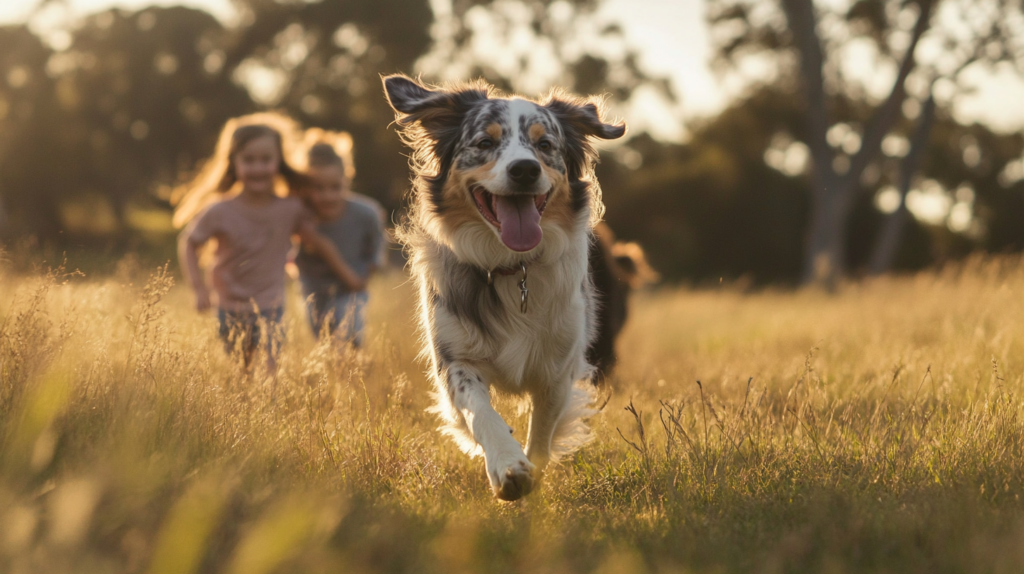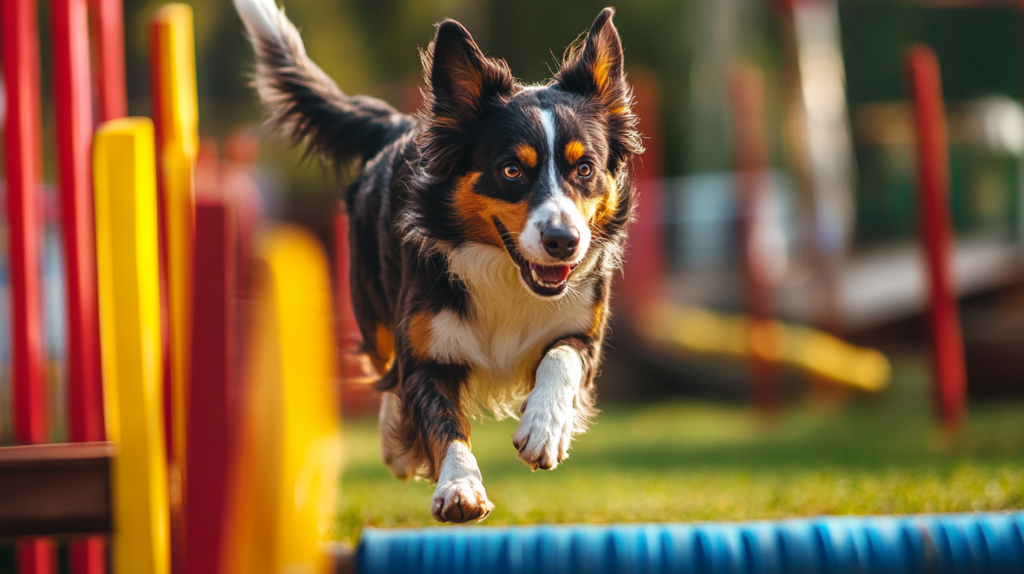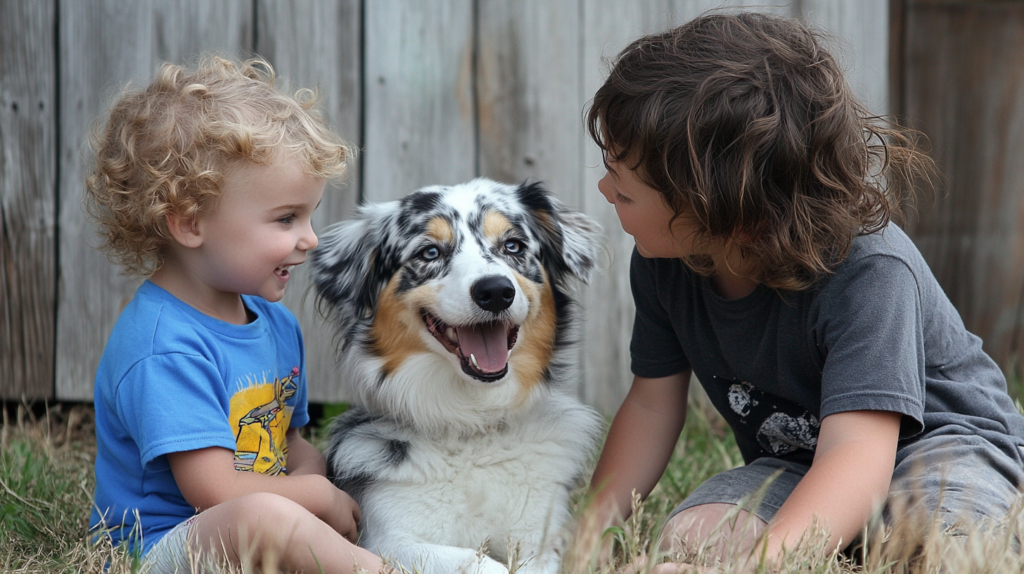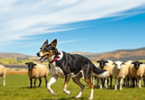Australian Shepherd Temperament and Personality: What to Expect
The Australian Shepherd is a medium-sized herding breed that has captured the hearts of many families around the globe. Known for their intelligence and versatility, these pups originated in the United States, primarily developed for herding livestock.
Key features of Australian Shepherds include:
- High Energy Levels: They thrive on activity and require plenty of exercise.
- Loyal Companions: Their affectionate nature makes them beloved family pets.
- Protective Instincts: Aussies are naturally protective, showcasing their Australian Shepherd protective nature.
Understanding the Australian Shepherd temperament and personality traits is crucial for potential owners. This insight helps determine if an Aussie’s lively and engaging spirit aligns with your lifestyle. From their eager-to-please attitude to their social tendencies, getting to know the Aussie dog personality traits will ensure a happy match between you and your new furry friend.

1. Key Characteristics and Personality Traits of Australian Shepherds
Australian Shepherds have a combination of qualities that make them unique among dogs. They are one of the smartest breeds, which helps them excel in various activities and sports. This intelligence also makes them eager learners and quick problem-solvers. Here are some key personality traits that define Australian Shepherds:
1. High Energy Levels
These dogs are full of energy and love to be active! They thrive on physical exercise and mental challenges, making them perfect companions for families who enjoy outdoor adventures.
2. Strong Work Ethic
Originally bred as herding dogs, Australian Shepherds have a natural instinct to work. This strong work ethic shows in their daily behaviors as they often look for tasks to do, whether it’s herding children in the yard or organizing toys around the house.
3. Affectionate Nature
While they may seem focused on their jobs, Australian Shepherds are also very loving. They form close bonds with their families and enjoy spending time with their humans, showing loyalty that runs deep.
4. Sociable Attitude
Generally friendly and outgoing, these dogs love interacting with both people and other pets. It’s important to socialize them early on so they develop good manners and become well-rounded companions.
The playful behavior of Australian Shepherds during playtime or training sessions highlights their personality traits. Their intelligence means they respond best to positive reinforcement techniques, making training enjoyable and effective.
To truly understand how Australian Shepherds behave, it’s essential to recognize how their herding instincts shape their actions. These instincts can lead to unique behaviors such as chasing moving objects or even trying to herd family members. By embracing these traits while providing proper guidance, you can ensure a fulfilling life for both your Aussie and your family.

2. The Role of Genetics in Aussie Temperament
Understanding the genetics and temperament in dogs reveals fascinating insights into the Australian Shepherd’s personality. Each bloodline can influence various traits, leading to diverse behaviors and temperaments within the breed.
1. Working Lines vs. Show Lines
- Working Line Aussies are bred for herding instincts, often displaying higher energy levels and a more intense drive to work. These pups thrive in active environments and excel at dog sports.
- Show Line Aussies, while still energetic, may exhibit a calmer demeanor, often being more sociable and relaxed around children and other pets.
2. Genetic Variability
Different bloodlines can lead to variations in temperament. For instance:
- An Aussie with children from a well-socialized line might be incredibly gentle, making them great family companions.
- Conversely, one from a less socialized background could be wary or shy around new people or pets.
The genetic predisposition to certain traits shapes not only how they interact with humans but also their behavior with fellow dogs. Ensuring a well-rounded temperament often begins with choosing a puppy from a reputable breeder who prioritizes both health and socialization in their breeding program. Understanding these genetic influences provides valuable insight into how an Aussie might behave in various settings.
3. Herding Instincts: A Double-Edged Sword
Australian Shepherds have a natural herding instinct that comes from their history as herding dogs. This instinct influences how they behave, interact with humans, and get along with other animals. While it can be a charming part of their personality, it also brings specific challenges for owners.
Behavioral Implications
The herding behavior in Australian Shepherds often shows up in different ways:
- Nipping: They may nip at the heels of children, pets, or even adults as a way of “herding” them.
- Chasing: An Aussie might chase after moving objects, whether it’s a ball or a passing car.
- Protectiveness: With their strong loyalty to family, they might display protective behaviors towards their loved ones.
Understanding these traits is crucial for potential owners, especially those wondering, Are Aussies good with kids? The answer depends on proper management and training to ensure harmonious relationships.
Channeling Their Instincts
Using this strong herding drive positively can turn potential behavioral problems into constructive activities:
- Agility Training: Engaging your Aussie in agility courses not only satisfies their need for movement but also taps into their problem-solving skills.
- Herding Exercises: If you have access to livestock, supervised herding can provide an outlet for this natural behavior.
- Interactive Games: Games like fetch or frisbee not only offer physical exercise but also stimulate their minds.
By understanding and guiding the herding instincts of Australian Shepherds, owners can raise a balanced pet who thrives in family life while managing those energetic tendencies.

4. Energy Levels and Exercise Needs
The Australian Shepherd is a prime example of a high energy dog. These remarkable pets were originally bred for herding, which naturally requires stamina, agility, and a zest for action. Their energy levels are nothing short of impressive, making regular exercise an essential part of their daily routine.
Why Regular Exercise Matters
- Physical Well-being: Adequate exercise prevents obesity and the myriad health issues that accompany it. An active Aussie is a healthy Aussie.
- Mental Stimulation: Engaging in physical activity also combats boredom. A mentally stimulated dog is less likely to develop destructive behaviors stemming from excess energy.
- Bonding Time: Exercise provides an opportunity for you and your furry friend to strengthen your bond through shared activities.
Recommended Daily Exercise Routine
A tailored exercise routine can keep your Australian Shepherd thriving:
Daily Walks (30 to 60 minutes):
- Incorporate brisk walks around the neighborhood or park. Vary the route to keep things exciting!
Playtime Activities:
- Fetch games can satisfy their instinctive chase drive.
- Tug-of-war promotes physical interaction while reinforcing obedience training.
Agility Training:
- Set up an obstacle course in the backyard or join a local agility class. This not only keeps them fit but also challenges their intelligence.
Mental Games:
- Puzzle toys that require problem-solving skills can be excellent for mental engagement.
- Hide-and-seek games encourage them to use their keen sense of smell while having fun!
Social Outings:
- Visit dog parks where they can run freely and interact with other dogs. This socialization is vital for their development.
Understanding the exercise needs of Australian Shepherds lays the groundwork for a happy, well-adjusted pup. Keeping them engaged physically and mentally helps channel their vibrant energy into positive behaviors and strengthens your connection with them as their loving owner.

5. Mental Stimulation Requirements: Keeping Their Minds Sharp
Australian Shepherds are highly intelligent dogs that require mental stimulation in addition to physical exercise. Engaging their minds through various activities is essential for their overall well-being, as it helps prevent boredom and undesirable behaviors that may result from inactivity.
Fun Ways to Challenge Your Aussie:
- Interactive Toys: Use puzzle toys filled with treats to keep your Aussie entertained and mentally stimulated. These toys encourage problem-solving skills while rewarding them for their efforts.
- Hide and Seek: Play a game of hide and seek with your dog. Hide in one room while your Aussie stays in another, then call them to find you. This game not only provides mental stimulation but also strengthens the bond between you and your pet.
- Agility Training: Set up a mini obstacle course in your backyard or local park. Teach your Aussie to navigate through tunnels, jump over obstacles, and weave between poles. This activity challenges their intellect while providing a fun way to exercise.
- Trick Training Sessions: Spend dedicated time teaching your Australian Shepherd new tricks such as “roll over” or “play dead.” Use positive reinforcement techniques like treats and praise to make the learning process enjoyable.
- Scent Games: Hide treats around the house or yard and encourage your dog to use its nose to find them. This taps into their natural herding instincts and provides a mental workout.
Incorporating these activities into your Australian Shepherd’s daily routine enriches their lives, ensuring they remain happy and engaged companions. A well-stimulated mind complements their high energy levels, leading to a more balanced temperament and behavior.

6. Training Tips for an Obedient Aussie
Australian Shepherds are highly trainable. Their natural desire to please their owners, combined with their quick learning abilities, makes them exceptional students in the world of dog training.
Key Training Insights:
- Eager Learners: Australian Shepherds thrive on learning new skills and commands. Their intelligence often leads them to pick up tricks faster than you can say “fetch!”
- Positive Reinforcement: This breed responds exceptionally well to positive reinforcement training methods. Use treats, praise, or playtime as rewards for good behavior.
Effective Techniques:
- Consistency is Key: Establish clear commands and stick to them. Inconsistent cues can confuse your Aussie and hinder their learning process.
- Short Training Sessions: Keep training sessions brief but engaging—about 5 to 10 minutes is ideal. This prevents boredom while maintaining focus.
- Variety Matters: Incorporate a mix of commands and tricks into training routines. This stimulates their minds and keeps them excited about learning.
- Socialization During Training: Include socialization as part of the training routine. Exposing your Aussie to different environments, people, and pets will enhance their adaptability and confidence.
Fun Fact:
Did you know that Australian Shepherds excel in dog sports? Their agility, obedience, and herding trials showcase not only their impressive trainability but also their delightful personality traits.
By using positive reinforcement techniques to tap into the trainability of Australian Shepherds, you’ll develop a well-behaved companion who is always prepared for the next adventure!

7. Socialization Needs: Ensuring Well-Rounded Behavior
Socialization needs in Australian Shepherds are essential to developing a well-adjusted companion. Early socialization experiences play a crucial role in shaping their temperament. Without proper exposure, these intelligent pups might become shy or defensive around strangers and unfamiliar situations.
Key Areas for Socialization:
- People: Introduce your Aussie to various individuals, including men, women, and children. Encourage positive interactions through treats and praise.
- Animals: Allow your dog to meet other pets, both dogs and non-dogs. Supervised playdates can foster friendly behavior.
- Environments: Take them on walks in different settings—parks, busy streets, or beaches. This variety helps them adapt to new sights and sounds.
Practical Tips:
- Start Early: Begin socialization as soon as you bring your Aussie home, ideally between 3 to 14 weeks of age.
- Positive Reinforcement: Use treats and praise during introductions to create positive associations with new experiences.
- Controlled Exposure: Gradually increase exposure intensity; start with quieter environments before moving to busier places.
By investing time in socializing your Australian Shepherd, you’ll nurture a confident, friendly companion ready to embrace the world!

8. Family Life with an Aussie: Compatibility Factors
Australian Shepherds are often celebrated as fantastic family dogs, bringing joy, energy, and fun into any household. Their lively spirit and affectionate nature make them ideal companions for children and other pets. Let’s delve into what makes these furry friends such great additions to family life.
Aussie Temperament with Children
- Energetic Playmates: Australian Shepherds are known for their boundless energy and playfulness. They love engaging in games of fetch, tug-of-war, or even agility courses, making them perfect companions for active kids.
- Loyal Guardians: With their protective instincts, Aussies are naturally inclined to watch over their families. They bond closely with children and can be quite affectionate, providing a comforting presence.
- Teach Responsiveness: When raised alongside children, Aussies often learn to be gentle and patient. Early training can enhance their ability to interact positively with kids.
Considerations for Other Pets
- Herding Instincts: While they can coexist beautifully with other animals, their strong herding drive may lead them to chase smaller pets or even nip at heels during play. Monitoring interactions is essential to ensure everyone feels safe.
- Socialization Requirement: Introducing your Aussie to various pets during their formative months helps shape their behavior. Proper socialization can encourage friendly interactions rather than instinctual herding tendencies.
Supervision Is Key
To cultivate harmonious relationships between your Aussie and family members—whether human or animal—supervision is crucial:
- Monitor Playtime: Always keep an eye on play sessions between your Aussie and young children or smaller pets. This ensures no one gets overwhelmed by the excitement.
- Teach Boundaries: Helping your dog understand how to engage respectfully with others will lead to positive experiences for all involved.
With proper supervision and guidance, Australian Shepherds thrive in family settings, proving themselves as loving companions that enhance the household’s dynamic.

9. Managing Behavioral Challenges: From Nipping to Boredom Busting Strategies
Understanding undesirable behaviors in Australian Shepherds requires a keen awareness of their energetic and intelligent nature. Without sufficient physical exercise or mental stimulation, these clever canines may resort to various behavioral issues, such as:
- Nipping: A common behavior often linked to herding instincts. An Aussie may nip at heels or hands, especially if feeling anxious or bored.
- Barking: Excessive barking can occur due to boredom or a lack of engagement, particularly if they feel under-stimulated.
- Destructive Chewing: Left alone without activities, they might chew furniture or personal items as a way to cope with their energy and anxiety.
Addressing these challenges effectively relies on positive reinforcement techniques that align with their temperament and personality traits. Here are some practical solutions:
- Regular Exercise: Aim for at least 30 to 60 minutes of vigorous activity daily. Activities like fetch, agility courses, or long walks can work wonders in burning off excess energy.
- Interactive Toys: Invest in puzzle toys that stimulate their minds while keeping them occupied. Treat-dispensing toys encourage problem-solving and reward-seeking behaviors.
- Training Sessions: Incorporate short training sessions throughout the day focused on basic commands or tricks. This not only reinforces good behavior but also strengthens the bond between you and your Aussie.
- Socialization Opportunities: Arrange playdates with other dogs to provide healthy outlets for their energy and reinforce good manners.
By implementing these strategies, owners can help curb undesirable behaviors while nurturing a happy, well-adjusted Australian Shepherd who thrives on companionship and activity.

10. Health Considerations That Can Influence Behavior
Australian Shepherds are generally robust and energetic, but they can be prone to specific health issues that may influence their behavior. Here are some common conditions:
- Hip Dysplasia: This genetic condition affects the hip joint, leading to pain and mobility issues. An Australian Shepherd suffering from hip dysplasia may become less active, which could lead to frustration or behavioral changes.
- Progressive Retinal Atrophy (PRA): This hereditary eye disorder can result in gradual vision loss. An affected dog might display signs of anxiety or confusion as their environment becomes less familiar.
Regular veterinary check-ups play a vital role in maintaining your Aussie’s health and well-being. Early detection of potential problems allows for timely intervention, which can mitigate behavioral changes associated with discomfort or pain.
Keeping a close eye on your Australian Shepherd’s physical condition can provide insights into their temperament. A healthy dog is typically happier and more engaged, while underlying health issues may lead to irritability or withdrawal. Prioritizing your furry friend’s health ensures they remain the lively companion they were meant to be!
Conclusion: Is an Aussie Right For You?
Deciding whether to welcome an Australian Shepherd into your home requires careful consideration of their unique temperament and personality traits. Here are some key points to ponder:
- Active Lifestyle: Aussies thrive on physical activity and mental stimulation. If you lead a busy, active life, they might be the perfect companion.
- Family Dynamics: Their sociable nature makes them great pets for families, but supervision during playtime with kids and other animals is essential to ensure harmony.
- Training Commitment: Their intelligence means they need consistent training and engagement to prevent boredom-induced behaviors.
As potential owners, ask yourself: Do Australian Shepherds make good pets for my lifestyle? Understanding Aussie dog behavior can help you make an informed decision that leads to a rewarding relationship with this vibrant breed.

FAQs (Frequently Asked Questions)
What are the key personality traits of Australian Shepherds?
Australian Shepherds are known for their intelligence, high energy levels, and strong work ethic. They exhibit herding behavior and have a protective nature, making them both loyal companions and diligent workers.
How does genetics affect the temperament of Australian Shepherds?
Genetics play a significant role in shaping the temperament of Australian Shepherds. Different bloodlines may exhibit varying traits, influencing their behavior with children, other dogs, and their overall disposition.
What are the exercise needs of an Australian Shepherd?
Australian Shepherds require regular exercise to maintain their physical and mental well-being. A recommended daily routine includes 30 to 60 minutes of vigorous activity to channel their high energy levels effectively.
Why is mental stimulation important for Australian Shepherds?
Mental stimulation is crucial for Australian Shepherds as it helps keep their minds sharp and prevents boredom. Engaging them in interactive games and training exercises can enhance their problem-solving skills and overall happiness.
How can I effectively train my Australian Shepherd?
Training an Australian Shepherd can be highly rewarding due to their eagerness to please and quick learning abilities. Utilizing positive reinforcement techniques, such as treats and praise, is particularly effective with this breed.
Are Australian Shepherds suitable family pets?
Yes, Australian Shepherds can make excellent family pets. However, supervision during interactions with children and other pets is essential to ensure harmonious relationships due to their energetic nature and herding instincts.






